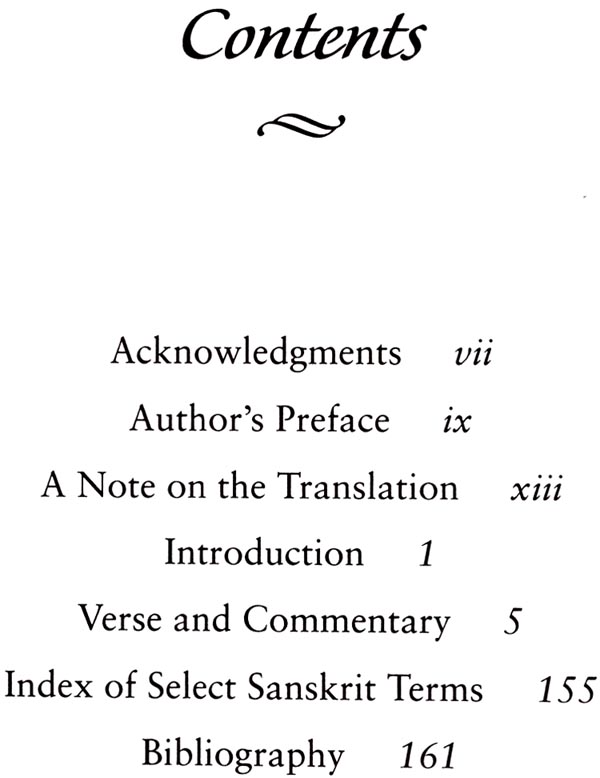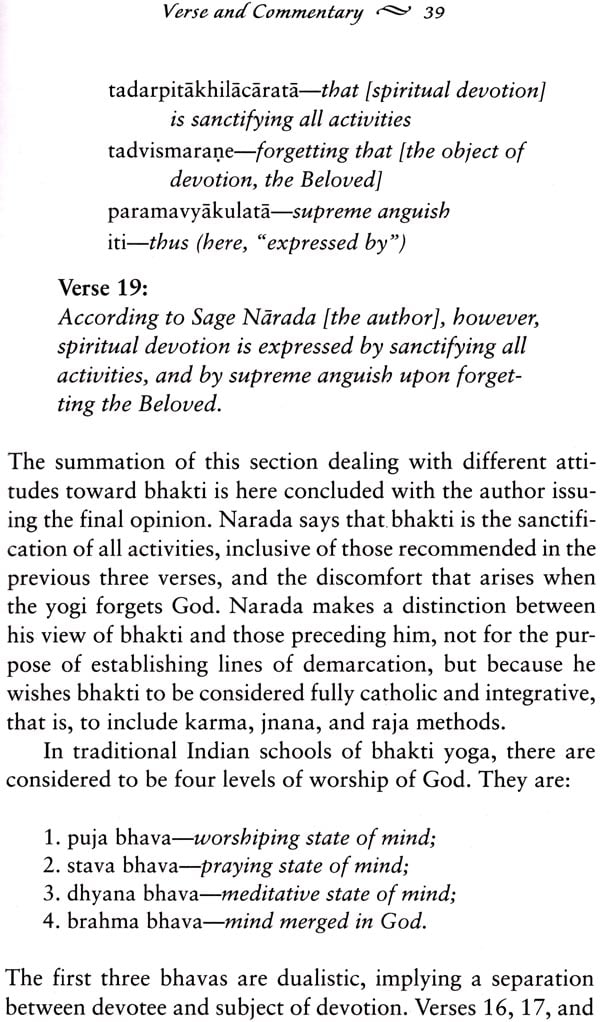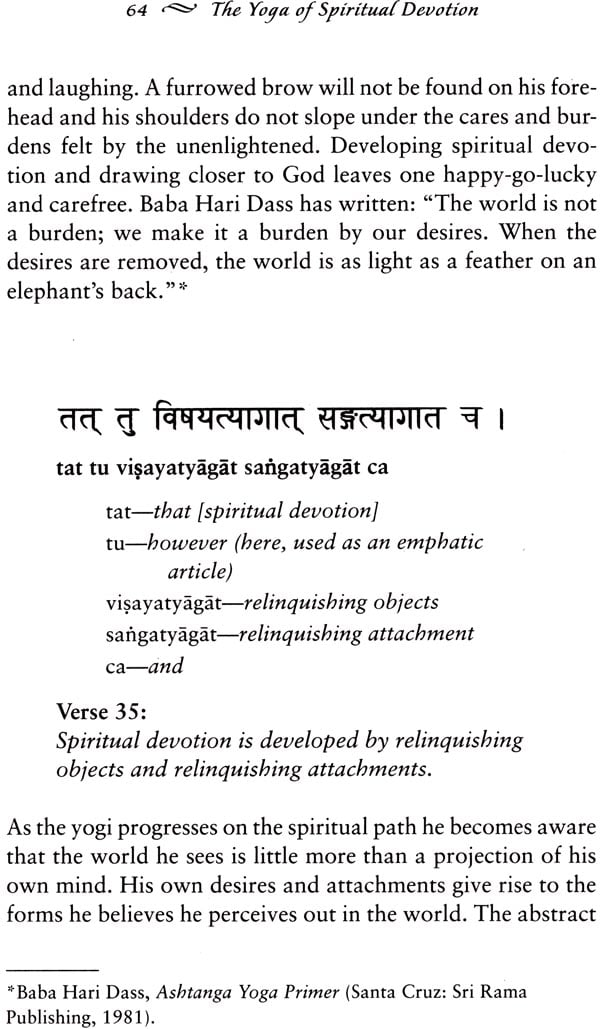
The Yoga of Spiritual Devotion (A Modern Translation of the Narada Bhakti Sutras)
Book Specification
| Item Code: | NAQ921 |
| Author: | Prem Prakash |
| Publisher: | Inner Traditions India Home Office. |
| Language: | Sanskrit Text With Word-to-Word Meaning English Translation |
| Edition: | 1998 |
| ISBN: | 9781620558898 |
| Pages: | 176 |
| Cover: | PAPERBACK |
| Other Details | 8.50 X 5.50 inch |
| Weight | 220 gm |
Book Description
"Bhakti yoga, the yoga of devotion and love, is little known and little appreciated in the West. Yet it is one of India's great spiritual legacies. Prem Prakash's book offers a sensitive introduction to the devotional path by a Western practitioner. He makes the ancient Bhakti Sutras of Narada come alive for all of us who wish to cultivate the beauty and power of the heart. Narada's aphorisms should be studied with the same earnestness as the Yoga Sutra and the Bhagavad Gita. I highly recommend the present book and hope it will widely influence the Western yoga movement.
Bhakti yoga, the path of devotion, is considered one of the primary paths for spiritual realization in yogic tradition. Its representative, Narada, is the embodiment of the enlightened sage who travels the universe spreading his sacred teachings and participating in kirtans-ecstatic songs and dances. Unlike acolytes of more world-negating types of yoga, the bhakti yogi does not discriminate against material phenomena, instead experiencing all phenomena as aspects of God. Within the context of ananda, blissful love, the temporal is realized as the reflection of the eternal, and the soul is realized as the expression of God.
Prem Prakash's sensitive translation and insightful commentary, aimed at making the path of love immediately accessible to Westerners, at last allows students of yoga to understand why many consider devotional yoga to be the most promising means by which one can transcend the limits and boundaries of the contemporary world and achieve direct experience of the divine.
PREM PRAKASH has been a practicing yogi since 1979 and in 1990 received permission from Baba Hari Dass to teach traditional ashtanga yoga. He is the director of the Green Mountain School of Yoga in Vermont.
Yoga is the science and art of the union of the individual soul with God. This union is not something to be generated or attained, per se; it already exists, needing only to be realized and expressed to its fullest potential. In the same manner that waves are already part of the ocean, being the very power of the ocean, likewise are the individual souls to God. The goal of bhakti yoga, the path of spiritual devotion, is the realization of this relationship between the soul and God.
In the yogic traditions God's nature is described as sat-chit-ananda: eternal life, infinite consciousness, and limitless bliss. God is the One-the timeless, universal consciousness of unconditional love, as well as the source of the souls and their own creative impetus. The individual soul is a spark from the sun of God that experiences the universe during a journey in the manifest worlds.
The individual soul is the same sat-chit-ananda nature as God, but the soul's voyage in the spheres of relative existence engenders a confusion of identity. Through identification with the various bodies she produces, which are the vehicles that make the voyage possible, the soul forgets her true nature. She comes to believe she is those bodies, and hence, that she is mortal, limited, and subject to suffering. This confusion is not due to any original sin deserving punishment from God; it is a primal energy that is itself the seed of the cosmic drama of separation and reunion.
Suffering reaches its most poignant state in a human being, awakening a sense that "all is not well." This recognition of elementary dissatisfaction is the beginning of the conscious spiritual pilgrimage by the soul. She begins to search for answers that address the causes of suffering and its appeasement. The contemplative power of the soul, the intuition, begins to raise the Great Question, the atma-vichara: "Who am I?"
The soul spends many incarnations exploring this question and the multitude of answers available in the world. Finally she reaches the point where the atma-vichara becomes the primary influence in life, and the search for a satisfactory answer motivates the undertaking of spiritual practice.
The yogic tradition provides two principal paths of spiritual practice. One is the path of jnana yoga, the yoga of wisdom, for those oriented toward answering the atma-vichara in terms of sat (eternal truth). The jnana yogi performs a dissection of the eternal soul from its bodily vehicles and external environment. Through this process the soul realizes herself as distinct from all that is temporal and prone to suffering.
The jnana yogi applies the axiom Neti, neti, "not this, not this," to all phenomena that can be identified as being transient, until what alone is eternal is distilled. Within the context of sat, the temporal forms are realized as in-sentient manifestations resulting from the intercourse of objects, senses, and mind. The soul is realized as the eternal conscious witness to this process of nature.
The second primary yogic path is that of bhakti yoga, or the yoga of spiritual devotion. It is this path that this book addresses. Bhakti yoga is for those oriented toward answering the atma-vichara in terms of ananda (blissful love). The bhakti yogi performs a dissection of pure love from all that contains a contamination of selfishness. By making love his polestar, the bhakti yogi follows its light along the path of life until the soul realizes it is one with that light.
The bhakti yogi does not undertake processes involving discrimination against phenomena, for to him all phenomena are reflections of God. He seeks to see all form as partial manifestations of shakti, God's creative, intelligent energy. Within the context of ananda, the temporal is realized as the reflection of the eternal, and the soul is realized as the expression of God.
A comparison of these two paths is provided in this book (verses 25-33). Also in this text is an examination of the roles played in spiritual development by karma yoga (selfless activity) and raja yoga (Patanjali's system of meditation). For the moment it will suffice to say that, while all paths lead to the mountain summit, these bhakti sutras declare that spiritual devotion is the simplest, easiest, and most accessible (verses 58-60).
The Narada Bhakti Sutras are considered to have been composed sometime around the twelfth century A.D. It is possible that they were transmitted orally before being circulated in writing. The authorship is attributed to Narada, an archetypal figure of spiritual devotion mentioned through-out millennia of yogic writings.
Narada is said to be a realized sage who travels through-out the universe, often singing and playing the viva, a stringed instrument of India. His mission is the dissemination of the teachings of bhakti yoga, and his pastime is participation in ecstatic kirtan (chants and songs to God). Some believe that when a kirtan becomes highly charged it will attract Narada, whose subtle presence can be experienced by the participants.
The contentions that Narada is a figure of antiquity and somehow the author of these sutras, a pseudonym employed by the author of these sutras, or some other possibility are all, for practical purposes, equally plausible. The work is neither elevated nor diminished by the status of its author. The Narada Bhakti Sutras are revered because they are a concise summation of an authentic spiritual path and they pro-vide a thorough set of guidelines by which an aspirant can attain Self-realization. Questions of scholarship can remain with scholars. The experience of God awaits those who practice the yoga described in this text.
**Contents and Sample Pages**












